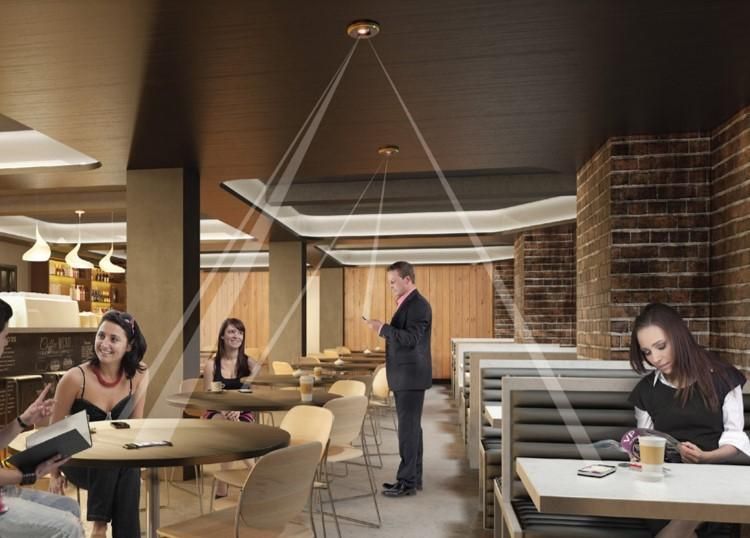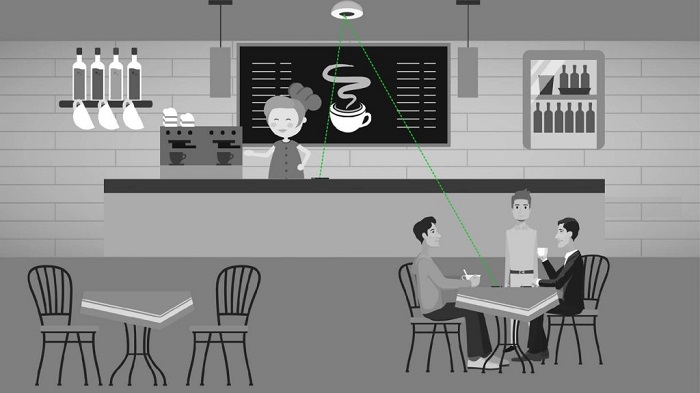By Maurizio Di Paolo Emilio, editor-in-chief, Power Electronics News
Wi-Charge’s new AirCord infrared-beam technology offers the possibility to wirelessly charge compatible smart or IoT devices using light from distances up to 10 meters. The most significant advantage of long-range wireless charging is that it eliminates the need to replace batteries or manage various chargers and power cables. Charging also occurs automatically whenever the device is within range of a suitable charger. And you only need to install a single wireless charger to power multiple devices at once.

One example, highlighted at the Consumer Electronics Show (CES) earlier this year, is using the Wi-Charge receiver in a flush valve to automatically flush a toilet when someone leaves the urinal or the bathroom stall.
“One important reason is that in a commercial bathroom like in an airport or sports stadium, a lot of these touchless devices — the faucets, urinals, etc. — [are] all battery-operated,” said Yuval Boger, chief marketing officer, Wi-Charge. “And the reason they’re battery-operated is that the person installing them did not want to redo the entire bathroom — taking out the tile, running wires, and putting the tiles back in.
“And because they’re battery-operated, the batteries are the weakest link, so wireless power allows you to keep them running endlessly,” he added.
Power is delivered with millimeter precision using safe, focused, and invisible rays of light. The transmitter uses a standard 12-V power supply and can cover about 25 square meters, while the various receivers include a small photovoltaic cell (essentially a small solar cell) to convert the light received into abundant usable electricity. The receivers can be integrated into a device or connected to an existing charging port. The process of sending energy is fully automatic and safe and supports many simultaneous and moving devices.
Wi-Charge stated that its technology complies with IEC 60825-1 international safety standard (laser safety). According to this standard, it is a Class 1 product. The technology requires no configuration and provides extensive coverage. Multiple transmitters can be combined to increase coverage and power. It does not interfere with cellular, Wi-Fi, Bluetooth, or other communications and also does not emit ionizing radiation (Fig. 2 ).
Wi-Charge products are classified at the same safety level as an optical mouse or laser printer, so there are absolutely no limits on what you can do with it and no additional safety precautions to take.

A functional layout of the Wi-Charge AirCord technology: The transmitter automatically finds devices to be powered; power is delivered with pinpoint accuracy by an invisible beam; and if the light is blocked, the transmission is stopped until the path is clear again. (Image: Wi-Charge)
Developing a wireless power delivery system requires years of research and study to finalize the best source to use. It is important to initially consider various sources such as magnetic fields, radio-frequency (RF) waves, ultrasound, and, of course, light.
“When people talk about RF energy harvesting, they look at one thing: Can I get a little bit of energy from just a regular Wi-Fi signal? And the answer is yes, but they could only get microwatts,” said Boger. “And the reason is that the FCC and other safety bodies limit the power coming from an RF router to about one watt. So by the time the signal gets to the device, you only get about one microwatt of energy.”
Wi-Charge doesn’t think it makes a lot of sense to use RF for wireless charging for a couple of reasons.
“One is safety issues, and number two is because RF signals have an inherent physics limitation (diffraction) that causes very low efficiency,” said Boger. “You only get very small amounts of power at a distance using a small receiver.”
The Wi-Charge system transmits power using a narrow straight beam that is contained in a small point, and all the energy falls inside the receiver, said the company. Therefore, no one is exposed to radiated energy unless the path between the transmitter and receiver is crossed. However, if the path between the transmitter and receiver is blocked, the transmission stops immediately. Once the line of sight is restored, charging resumes.
The long-range wireless power supply using infrared light allows you to freely deliver power without the need for cables. By integrating a wireless receiver into a smart lock, for instance, charging and maintaining power may no longer be an issue. The lock gets all the power it needs to enable new features such as video recording without ever replacing the batteries.
Wireless charging eliminates the trade-off between functionality and battery life. Smart locks, as well as other security cameras, sensors, and other smart home devices can benefit greatly from long-life batteries.
Advertisement
Learn more about Electronic Products Magazine





